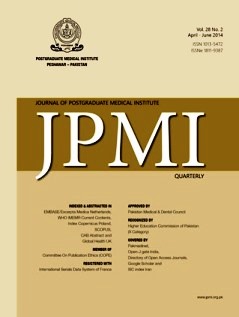Spinal cord injury without radiographic abnormalities (SCIWORA) in a preschool child: A case report
Main Article Content
Abstract
A 3½ year old boy presented at the Soldiers' Family Rehabilitation Unit, ArmedForces Institute of Rehabilitation Medicine, Rawalpindi with 2½ years' historyof weakness and numbness in legs and loss of control over bowel and bladderfollowing run over by a vehicle. At presentation, the child was unable to standwithout support with power of 2/5 in iliopsoas, 3/5 in extensor hallucis longusand 0/5 in ankle plantar flexors on both sides. The power in quadriceps was0/5 on right and 2/5 on left side. The knee and ankle jerks were absent bilaterally.Sensations to both light touch and pin prick were impaired below T9 levelon both sides. Perianal sensations were intact but voluntary anal contractionwas absent. He was categorized as a case of Spinal Cord Injury T9 as classifiedby American Spinal Injury Association (ASIA) with impairment Scale C. X-Raysand Magnetic Resonance Imaging Scans were normal. These investigationsaided by relevant clinical features qualified him as a case of Spinal Cord Injurywithout Radiographic Abnormalities.
Article Details
Work published in JPMI is licensed under a
Creative Commons Attribution-NonCommercial 2.0 Generic License.
Authors are permitted and encouraged to post their work online (e.g., in institutional repositories or on their website) prior to and during the submission process, as it can lead to productive exchanges, as well as earlier and greater citation of published work.


